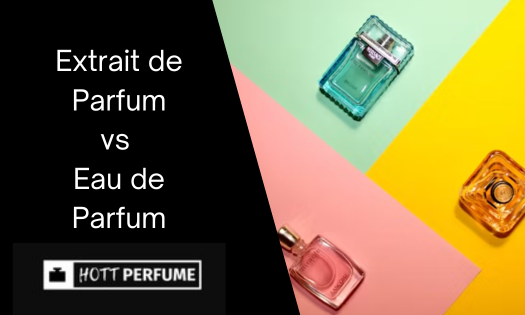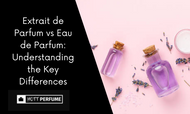Extrait de Parfum vs Eau de Parfum: Understanding the Key Differences
Posted by Tina Wilson on Aug 24th 2025

Introduction to Perfume Concentrations
Perfume concentrations refer to the percentage of fragrance oils in a perfume, which directly impacts its intensity and longevity. Understanding these concentrations, particularly eau de parfum, is essential for choosing the right fragrance that suits your preferences and needs.
The concentration of perfume oil determines how strong the scent is and how long it lasts on your skin. Among the various types, extrait de parfum (also called perfume extract) contains the highest concentration of fragrance oils, typically between 20-30%. This makes it a potent, long-lasting, and luxurious option. Luxury and niche perfumes often feature higher concentrations like extrait de parfum, while eau de parfum and eau de toilette have lower concentrations, offering different scent experiences and wear times.
Understanding Fragrance Oil Concentration
Fragrance oil concentration refers to the percentage of essential oils in a perfume, which typically ranges from about 5% in eau de cologne to as high as 40% in extrait de parfum—the category with the highest concentration of fragrance oils, which is known as the most concentrated form of fragrance .
-
Eau de Parfum: Usually contains 15-25% fragrance oils, offering a long-lasting and more intense scent compared to eau de toilette or eau de cologne.
-
Other Types: Perfume types such as colognes, eau de toilette, eau de parfum, and extrait de parfum differ in their oil concentrations, which directly influence their scent longevity and intensity.
-
Intensity and Longevity: The higher the concentration of fragrance oils, the stronger and longer-lasting the scent. Extrait de parfum, with the highest concentration, is ideal for special occasions due to its potency.
-
Categories: Perfume concentrations are broadly categorized into colognes, eau de cologne, eau de toilette, eau de parfum, and extrait de parfum, each offering unique scent experiences.
Understanding these differences helps you select a fragrance that matches your desired intensity and wear time.
Eau de Toilette vs Parfum: Key Differences and Choosing
Extrait de Parfum Characteristics
Extrait de parfum is the most concentrated and potent form of fragrance, offering a rich and long-lasting scent experience, often referred to as pure parfum . Key features include:
-
Contains 20-40% fragrance oils, making it highly concentrated.
-
Known as pure perfume or parfum, emphasizing its strength.
-
Provides a potent, long-lasting fragrance ideal for evening or formal wear.
-
Features a rich, intense scent that lingers for hours.
-
Creates a personal, sensual experience with a lasting impression.
-
Perfect for those who want a bold, statement-making fragrance.
Eau de Parfum Edp Characteristics
Eau de parfum (EDP) is a widely favored fragrance concentration known for its balanced and long-lasting scent, and eau de parfum offers a great option for daily wear. Key characteristics include:
-
Contains 15-25% fragrance oils, offering moderate concentration.
-
Lighter scent profile compared to extrait de parfum, making it suitable for everyday wear.
-
Often features fresh, vibrant notes that appeal to daily use.
-
Provides a subtle yet enduring fragrance experience.
-
Ideal for those seeking a scent that lasts throughout the day without being overpowering.
Usage Scenarios
Different fragrance concentrations, which include heart and base notes, suit different occasions and preferences:
-
Extrait de Parfum: Best for special events, evenings, and cooler weather.
-
Eau de Parfum: Great for everyday wear with balanced longevity.
-
Eau de Toilette & Eau de Cologne: Ideal for casual, daytime, or refreshing use.
-
Choice Factors: Depends on lifestyle, occasion, and personal taste.
Eau de Toilette vs Parfum: Choosing the Right One
Key Differences Between Extrait de parfum vs Eau de parfum
|
Feature |
Extrait de Parfum (Pure Parfum) |
|
|---|---|---|
|
Fragrance Oil Concentration |
Typically 15-25% |
Typically 20-40% |
|
Intensity |
Balanced, lighter scent suitable for everyday wear |
More intense, richer, and bold scent ideal for special occasions |
|
Longevity |
Lasts about 4-6 hours on the skin |
Lasts 8 hours or more |
|
Sillage |
Moderate scent trail |
Strong, pronounced scent trail |
|
Scent Profile - For a comprehensive overview, check out this review of YSL Myself Cologne. |
Fresher, more refreshing |
Richer, deeper, and more potent |
|
Suitability |
Great for those wanting a subtle, long-lasting fragrance, or looking to score the best deals on their favorite perfumes. |
Perfect for those wanting a strong, lasting impression |
|
Usage |
Suitable for daily wear and casual occasions |
Ideal for evening wear, formal events, and special occasions |
|
Choice Factors |
Depends on personal preference, lifestyle, and occasion |
Depends on personal preference, lifestyle, and occasion |
Summary:
Eau de parfum offers a balanced, refreshing scent with moderate longevity and sillage, making it perfect for everyday use. Extrait de parfum, with its higher concentration, delivers a more intense, long-lasting fragrance with strong projection, ideal for special occasions and those who want their scent to make a bold statement. The main difference when choosing between the two depends on your desired intensity, longevity, and the context in which you plan to wear the fragrance.
Conclusion
Extrait de parfum and eau de parfum are two distinct fragrance concentrations with different characteristics and uses. Understanding the differences between these concentrations, including perfume extract, can help you make an informed decision when selecting a perfume. Whether you prefer a strong, long-lasting scent or a lighter, more refreshing one, there is a fragrance concentration that suits your needs. By considering your personal preference, lifestyle, and the occasion, you can find the perfect fragrance that makes you feel confident and beautiful.


